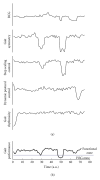Is freezing of gait in Parkinson's disease a result of multiple gait impairments? Implications for treatment
- PMID: 22288021
- PMCID: PMC3263650
- DOI: 10.1155/2012/459321
Is freezing of gait in Parkinson's disease a result of multiple gait impairments? Implications for treatment
Abstract
Several gait impairments have been associated with freezing of gait (FOG) in patients with Parkinson's disease (PD). These include deteriorations in rhythm control, gait symmetry, bilateral coordination of gait, dynamic postural control and step scaling. We suggest that these seemingly independent gait features may have mutual interactions which, during certain circumstances, jointly drive the predisposed locomotion system into a FOG episode. This new theoretical framework is illustrated by the evaluation of the potential relationships between the so-called "sequence effect", that is, impairments in step scaling, and gait asymmetry just prior to FOG. We further discuss what factors influence gait control to maintain functional gait. "Triggers", for example, such as attention shifts or trajectory transitions, may precede FOG. We propose distinct categories of interventions and describe examples of existing work that support this idea: (a) interventions which aim to maintain a good level of locomotion control especially with respect to aspects related to FOG; (b) those that aim at avoiding FOG "triggers"; and (c) those that merely aim to escape from FOG once it occurs. The proposed theoretical framework sets the stage for testable hypotheses regarding the mechanisms that lead to FOG and may also lead to new treatment ideas.
Figures



References
-
- Plotnik M, Hausdorff JM. The role of gait rhythmicity and bilateral coordination of stepping in the pathophysiology of freezing of gait in Parkinson’s disease. Movement Disorders. 2008;23(2, supplement 2):S444–S450. - PubMed
-
- Hausdorff JM, Schaafsma JD, Balash Y, Bartels AL, Gurevich T, Giladi N. Impaired regulation of stride variability in Parkinson’s disease subjects with freezing of gait. Experimental Brain Research. 2003;149(2):187–194. - PubMed
-
- Plotnik M, Giladi N, Hausdorff JM. Bilateral coordination of walking and freezing of gait in Parkinson’s disease. European Journal of Neuroscience. 2008;27(8):1999–2006. - PubMed
-
- Plotnik M, Giladi N, Balash Y, Peretz C, Hausdorff JM. Is freezing of gait in Parkinson’s disease related to asymmetric motor function? Annals of Neurology. 2005;57(5):656–663. - PubMed
LinkOut - more resources
Full Text Sources
Medical

